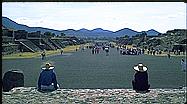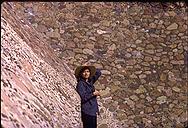

|
Chapter 3. Teotihuacan |
Before going to Mexico, we associated only two names with pre-Hispanic Mexico: the Mayans and the Aztecs. In Mexico, the Mayan ruins are in the Yucatan peninsula (eastern Mexico, on the Gulf of Mexico), where Cancun of air-conditioned sand fame has been made expensive by the North American visitor. Other Mayan sites are spread over bordering Guatemala and Belize. The Aztecs were a comparatively recent people, the indigenous kingdom that was overthrown by the conquistadores. A long line of civilizations went back in time before them. The Teotihuacans were one of their illustrious predecessors.
The journey to Teotihuacan from the Terminal Norte bus terminal takes only an hour - the bus was comfortable and inexpensive. The bus station itself was pretty neatly laid out (nothing like the infamous ISBT of New Delhi), provided with money changing counter, ATM and pasteleria. The pasteleria is a Mexican institution that is a boon to the hungry tourist looking for breakfast. These are bakery shops with an unvarying setup - food is laid out on open shelves, you take a tray and pick up whatever appeals to you visually, take it to the counter to have it packed and billed, pay up at the Caja (cash). Inexpensive, with no human tongue coming between appetite and fulfilment, it is one reliable meal in a foreign country (of course, if you're a vegetarian you're liable to suspect the contents of stuffed rolls, but that is a special case). The only thing these places lack is a provision for coffee, but with Dunkin' Donuts' making their appearance here and there, the Pasteleria owners should wake up to the situation.
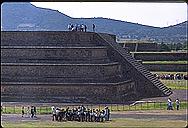
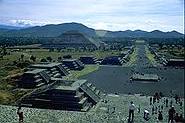 The ClubMed-run hotel at Teotihuacan, Villa Arceologica, was full -
however, they had
no problems keeping our backpacks; we had been somewhat undecided if we
ought to stay at Teotihuacan or go back to Mexico City - the decision now
stood taken for us. Following Lonely Planet advice, we got ourselves
some headgear - a sombrero with a red ribbon for Revathi, and a baseball
cap (both made of cane) for me - the Avenue of the Dead was long and
the sun was hot. This avenue is the centrepiece of Teotihuacan - at the
end of it is the Pyramid of the Moon, surrounding which are minor temples.
The Pyramid of the Sun and the Temple of Anotherunpronounceablediety
are the two other important structures.
The ClubMed-run hotel at Teotihuacan, Villa Arceologica, was full -
however, they had
no problems keeping our backpacks; we had been somewhat undecided if we
ought to stay at Teotihuacan or go back to Mexico City - the decision now
stood taken for us. Following Lonely Planet advice, we got ourselves
some headgear - a sombrero with a red ribbon for Revathi, and a baseball
cap (both made of cane) for me - the Avenue of the Dead was long and
the sun was hot. This avenue is the centrepiece of Teotihuacan - at the
end of it is the Pyramid of the Moon, surrounding which are minor temples.
The Pyramid of the Sun and the Temple of Anotherunpronounceablediety
are the two other important structures.
Like everywhere else in Mexico of historical interest, Teotihuacan was flooded with schoolchidren. There was a class going on with the kids seated on the angled, stepped wall of a temple; chorus of "Si.i.i.." would go up in answer to a question from the teacher; they were taking notes too - few teachers would have had such a dramatic lecture gallery, and such attentive students. Studies done, they would be huffing and puffing up the steep pyramids (cinquentahh, cinqueta-unoh, cihquehtahdohs...), faces flushed with effort, or crowding around one of those hawkers that all adult tourists abhor. The older kids swapped cameras with tourists for photographs; I learnt the Mexican equivalent of "say cheese" is "whisky".
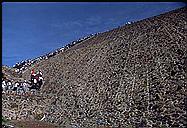
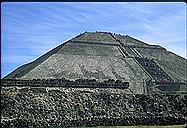
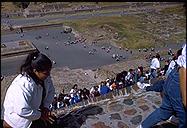
The site museum has shifted from where LP said it would be, but it was interesting nevertheless. One room was particularly imaginatively done: lumbering in wearily with a tourist's plodding foot, you suddenly take a deep breath ... and step gingerly onto the glass floor: below, a sprawling model of the entire complex - the Pyramids, palaces, temples. Barely have you overcome the wow of that when you look up to see the Pyramid of the Moon looming behind the glass wall of the room.
The frescoes in the "palaces" on the periphery of the site are in as bad a shape as the palaces themselves, and as such of interest only to a specialist. Pesos were running low, so I tried to change some dollars at the dusty roadside place where we had lunch. The lady had no problem in principle, but after I handed her the 20 dollar bill, she grew pensive, consulted a group of people around a table who passed around the bill from one to another; whatever their advice was, she must have thought that $20 on a non-gringo was too shady, and apologized that she didnt have 200 pesos in the till.
It was nearing four, we had seen everything of interest in Teotihuacan, and it turned out that staying the night there wasnt necessary after all. We got into one of the buses that had come with a load of tourists, and got back to Mexico City.
